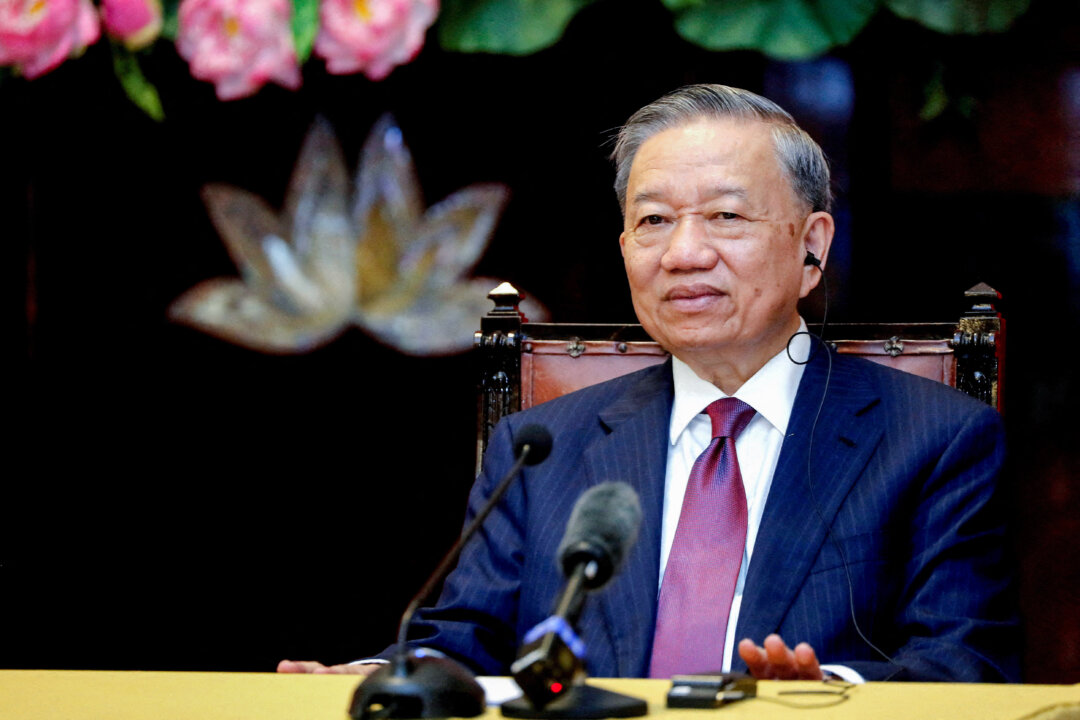Vietnam has pursued a strategy of so-called bamboo diplomacy, trying to flexibly balance relations between China, Russia, the United States, and others.
Vietnam’s new president To Lam has met with Chinese leader Xi Jinping in China on his first foreign trip as leader of the South Asian country.
The general secretary of the ruling Communist Party succeeded Nguyen Phu Trong as leader after Nguyen died last month at the age of 80.
Vietnam, under Nguyen, has pursued a strategy of so-called bamboo diplomacy—dubbed for the plant’s great flexibility—balancing relations between China, Russia, the United States, and others.
The visit on Aug. 19 comes months after Vietnam upgraded its diplomatic ties with the United States, as Western countries move their supply chains out of China and pivot to strengthen the liberal rules-based order in the Indo-Pacific.
To began his three-day visit on Sunday morning in Guangzhou, a major southern Chinese manufacturing and export hub near Hong Kong, and visited several locations including an address where Ho Chi Minh, founder of the Communist Party of Vietnam, carried out revolutionary activities, according to Chinese state media outlets CCTV and Xinhua News Agency.
He then set off to Beijing to meet Chinese leader Xi Jinping, who told To that Vietnam was “a priority in [China’s] neighborhood diplomacy.”
Xi said the Chinese Communist Party “supports Vietnam in adhering to the Party leadership, taking the socialist path suited to its national conditions, and deepening the cause of reforms and socialist modernisation,” according to Chinese official media Xinhua.
Vietnam, one of the five remaining communist countries in the world, established formal diplomatic ties with Beijing in 1950.
The strength of ties between the two communist regimes has always met with pressure as Vietnam tried to balance between Beijing and Moscow, while ties soured in the 1970s, culminating in the brief Sino-Vietnamese War of February 1979.
In 2008, both countries established a comprehensive strategic partnership (CSP) of cooperation—the highest level of diplomacy—that was jointly fortified in 2013 to address more shared international and regional issues of concern.
To’s visit will confirm the close ties between the two communist-run neighbors, which have well-developed economic and trade relations despite occasionally clashing over territorial boundaries in the energy-rich South China Sea.
The Chinese regime painted To’s visit as taking Xi’s trip to Vietnam in December a step further, citing “a good start” to the building of a “China-Vietnam community of shared future that carries strategic significance” when the Chinese foreign ministry announced the high-level visit.
The state visit marks To’s first after taking office, which Beijing said “fully reflects the great importance he attaches to the development of ties between both parties and countries.”
Both countries signed more than a dozen agreements last December that included strengthening railway cooperation and development, and establishing communication to handle unexpected incidents in the South China Sea. The details of the agreements were not made public.
Xi’s visit in December followed a trip to Hanoi by President Joe Biden in September, during which Biden and Nguyen agreed to elevate the U.S.-Vietnam Comprehensive Partnership established in 2013 to a CSP.
Besides China and the United States, Vietnam only has CSPs with Russia, which is the biggest exporter of arms to Vietnam, India, and South Korea.
In March, the U.S. Mission Vietnam said the two countries had advanced bilateral cooperation across a range of areas, including workforce, education, culture, business, law enforcement, climate, and public health. But the list did not include defense.
Earlier this month, the coast guards of Vietnam and Philippines held their first joint drill near Manila.
Reuters contributed to this report.

